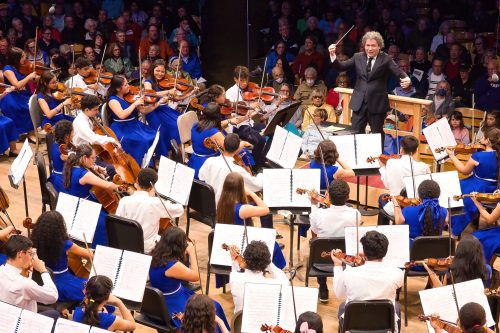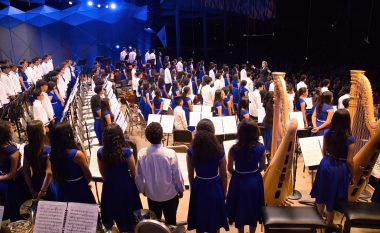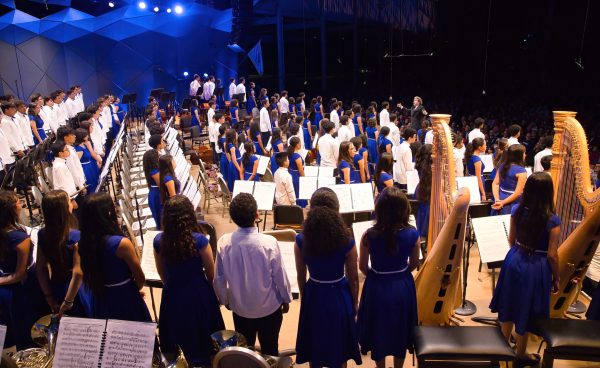 United States Tanglewood Festival 2024 [12] – Adams, Estévez, Ginastera, Shostakovich: National Children’s Symphony of Venezuela / Gustavo Dudamel (conductor), Koussevitzky Music Shed, Lenox, 8.8.2024. (CSa)
United States Tanglewood Festival 2024 [12] – Adams, Estévez, Ginastera, Shostakovich: National Children’s Symphony of Venezuela / Gustavo Dudamel (conductor), Koussevitzky Music Shed, Lenox, 8.8.2024. (CSa)

John Adams – Short Ride in a Fast Machine
Antonio Estévez – Mediodia en el Llano (‘Midday on the Prairie’)
Alberto Ginastera – Dances from Estancia (‘The Ranch’), Op.8
Shostakovich – Symphony No.5 in D minor, Op.47
The recent and much anticipated appearance at Tanglewood by the National Children’s Symphony of Venezuela (NCSV) under maestro Gustavo Dudamel – representing the fourth and final leg of their US tour – was not merely one of the musical highlights of this year’s festival, and a culturally significant and profoundly memorable event. It was also an amazing organisational triumph. Some 173 brilliantly accomplished young musicians aged 10-17 years plus instruments, accompanying adults and assorted administrators had flown from crisis-torn Venezuela to play in Los Angeles, New York, and Ravinia before their arrival in Lenox, Massachusetts.
The orchestra is a product of Venezuela’s transformative national music education programme which is commonly known as ‘El Sistema’ or ‘the System’. It was founded by José Antonio Abreu, a Venezuelan economist and amateur musician. In 1975, Abreu started Social Action for Music, with two principal objects: first, to prioritise music education throughout Venezuela, and secondly, to provide vulnerable and disadvantaged young people with an opportunity to escape lives of crushing poverty and crime. The programme has proved wildly successful in communities largely excluded from proper education and social privileges, and for over 30 years – both during periods of stability and political turmoil – has been funded by central government. This has resulted in the creation of hundreds of young people’s orchestras throughout Venezuela including, most famously, the Simón Bolivar Youth Orchestra. A principal beneficiary of El Sistema and Abrue’s former protégé is the charismatic Gustavo Dudamel or ‘The Dude’ as he is known to his many fans. Now just 43 years old, he was recently appointed Conductor Designate of the New York Philharmonic, after 14 years as Music and Artistic Director of the Los Angeles Philharmonic He was only 18 when he became the Music Director of the Simón Bolivar.
Dudamel, a committed advocate of El Sistema, fervently believes in the power of music education to change the world. As a proud Venezuelan and most prominent ambassador of ‘the System’, he stands at the complex interface of politics and music. He is not a political activist in the conventional sense, openly critical of the current regime. Nor is he, as some mistakenly believe, an apologist or front man for the country’s dictatorship. Recent criticism by human rights organisations accusing him of using the NCSV to provide cover for self-proclaimed President Maduro is wholly misconceived. In the words of American conductor and educationalist Leon Botstein, ‘To speak out against tyranny certainly takes courage, since speech is a form of action. But to [further] a programme with deep roots in society that develops the minds and skills of underserved and impoverished young people on a massive scale takes an altogether different form of courage.’
In a gentle admonition to the Venezuelan authorities from the podium of Tanglewood’s Koussevitzky shed, Dudamel pointed out to his critics that ‘the power of harmony is the best vehicle for change’ before launching into a widely varied, and technically challenging programme comprising works by John Adams, Antonio Estévez, Alberto Ginastera and Dmitri Shostakovich.
Dudamel decided to jump-start the evening with Adams’s high velocity Short Ride in a Fast Machine, and what better piece to harness the youthful ebullience of the players. Written in 1986, it depicts the composer’s experience of a white-knuckle trip in a friend’s ‘very fancy sports car’, and one he almost wished he hadn’t taken. The audience experienced no such regrets. The journey began slowly with the rhythmic beat of woodblocks, which were soon joined by gleaming trumpets, propulsive clarinets, synthesizers and sonorous strings as the music gathered pace. With his foot on the accelerator but his hands firmly on the wheel, Dudamel ran his orchestral engine with mechanised precision and ramped up the energy all the way to the thrilling conclusion.
Although hardly a pit-stop, Antonio Estévez’s leisurely pastoral tone poem Mediodia en el Llano (‘Midday on the Prairie’), a vast, swaying pampas of sound overlaid with tender melodies from the strings, provided an opportunity to admire the ability of the players to explore the luminous textures lurking beneath the music, and enabled us to marvel at the subtlety of instrumental techniques displayed.
One knew these gifted young musicians could play but who knew they could also sing as well? In a surprise departure from the published programme, the players downed their instruments, stood and joined together in a deeply spiritual and very beautiful rendition of two short choruses by Abreu himself: Sol que das vida a los trigos and Gloria in excelsis deo.
Next came a set of four Dances from Estancia, an adrenalin-fuelled orchestral suite by Argentinian composer Alberto Ginastera. Distilled from a ballet commissioned in 1942 for Lincoln Kirstein’s American Ballet, the piece bears the influence of Aaron Copland who Ginastera greatly revered, and who he met at Tanglewood in 1946. The orchestra clearly relished the first dance, an earthy, boisterous romp entitled Les trabajadores agrícolas (‘The Farm Workers’), and extracted a sweet lyricism from the second dance, Danza del trigo (‘Dance of the Wheat’). One could almost detect the rumbling of horses hooves and the coarse shouts of the hired hands in an evocatively performed Los peones de hacienda, while in the infectiously rhythmic fourth movement Malumbo, found the musicians in their element, swaying, swinging and joyfully raising their instruments like fully-fledged members of a 1930s dance band.
The second half of the concert was devoted to one work, Shostakovich’s Fifth Symphony. An interesting choice, given its historical and political context. Written in 1937 after Stalin’s personal condemnation of Shostakovich’s publicly acclaimed opera, Lady Macbeth of the Mtsensk District, the composer was officially rebuked and threatened with cultural banishment or worse. His symphonic response was a deeply ironic work which he inscribed ‘a Soviet artist’s creative reply to just criticism’. With its combination of heartfelt tragedy and satirical bombast, Shostakovich cunningly defied the authorities, ensuring his physical survival but preserving his artistic integrity. Many of the players in the NCSV were certainly too young to appreciate the symphony’s underlying nuances, but Dudamel, the public face and guardian of El Systema at a time of political upheaval in Venezuela, could not have been unaware of the parallels.

The orchestra certainly responded under Dudamel’s expressive baton, and to the genuine love he extends to his young charges. While understandably their performance lacked the physical heft and emotional depth that older and more experienced musicians can bring to bear, it was nonetheless an extraordinary technical accomplishment. Yes, the opening bars of the Moderato could perhaps have been more acerbic, and the pitiless, terrifying march section more dramatic, but the second movement Allegretto – a colourful peasant-like dance – was distinguished by lively contributions from the winds, and a delicately modulated conversation between first violin and principal flute was exquisite. A plaintive oboe solo introduced the Largo – a poignantly played lament in which the pianissimo strings hovered suspensefully – before the sardonic final Allegro non troppo. Here Dudamel encouraged the swelling brass and jarring percussion to let rip in chillingly relentless, and magnificently played goosestep coda. This thrilling performance which left one speculating as to what this band might accomplish ten years from now.
Although Shostakovich’s Fifth was the last dish on Dudamel’s published menu, it was by no means the end of the feast. Encores included Aldemaro Romero’s Fuga con pajorillo, a Bach-like fugue fused with a pajorillo style Venezuelan dance. The middle section featured four brilliant young musicians who jammed ecstatically on Llanera harp, cuatro, bass and maracas, drawing cheers and gasps of admiration from the capacity audience. Demanding yet more, the emotional crowd was rewarded with ‘Mambo’ from Leonard Bernstein’s West Side Story after which the beaming, dancing, instrument twirling orchestra and their conductor received roof-raising applause. Amid all the clapping, whooping and hollering, someone in the front row of the Shed’s auditorium unfurled a large Venezuelan flag. This was no hollow gesture of support for an autocratic dictator and his henchmen, but surely intended to celebrate El Sistema, and the power it gives young people to transform lives and change the world.
Chris Sallon

I relived this wonderful evening at Tanglewood through your incisive review.
Thank you, Suky Werman.
Your review made me sorry that I wasn’t there for this exquisite evening. Best, Carla Singer